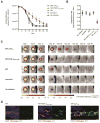Human Kunitz-type protease inhibitor engineered for enhanced matrix retention extends longevity of fibrin biomaterials
- PMID: 28477492
- PMCID: PMC5702589
- DOI: 10.1016/j.biomaterials.2017.04.048
Human Kunitz-type protease inhibitor engineered for enhanced matrix retention extends longevity of fibrin biomaterials
Abstract
Aprotinin is a broad-spectrum serine protease inhibitor used in the clinic as an anti-fibrinolytic agent in fibrin-based tissue sealants. However, upon re-exposure, some patients suffer from hypersensitivity immune reactions likely related to the bovine origin of aprotinin. Here, we aimed to develop a human-derived substitute to aprotinin. Based on sequence homology analyses, we identified the Kunitz-type protease inhibitor (KPI) domain of human amyloid-β A4 precursor protein as being a potential candidate. While KPI has a lower intrinsic anti-fibrinolytic activity than aprotinin, we reasoned that its efficacy is additionally limited by its fast release from fibrin material, just as aprotinin's is. Thus, we engineered KPI variants for controlled retention in fibrin biomaterials, using either covalent binding through incorporation of a substrate for the coagulation transglutaminase Factor XIIIa or through engineering of extracellular matrix protein super-affinity domains for sequestration into fibrin. We showed that both engineered KPI variants significantly slowed plasmin-mediated fibrinolysis in vitro, outperforming aprotinin. In vivo, our best engineered KPI variant (incorporating the transglutaminase substrate) extended fibrin matrix longevity by 50%, at a dose at which aprotinin did not show efficacy, thus qualifying it as a competitive substitute of aprotinin in fibrin sealants.
Keywords: Aprotinin; Fibrin biomaterial; Human Kunitz-type protease inhibitor; Plasmin; Protein engineering.
Copyright © 2017 The Author(s). Published by Elsevier Ltd.. All rights reserved.
Figures





References
MeSH terms
Substances
Grants and funding
LinkOut - more resources
Full Text Sources
Other Literature Sources

